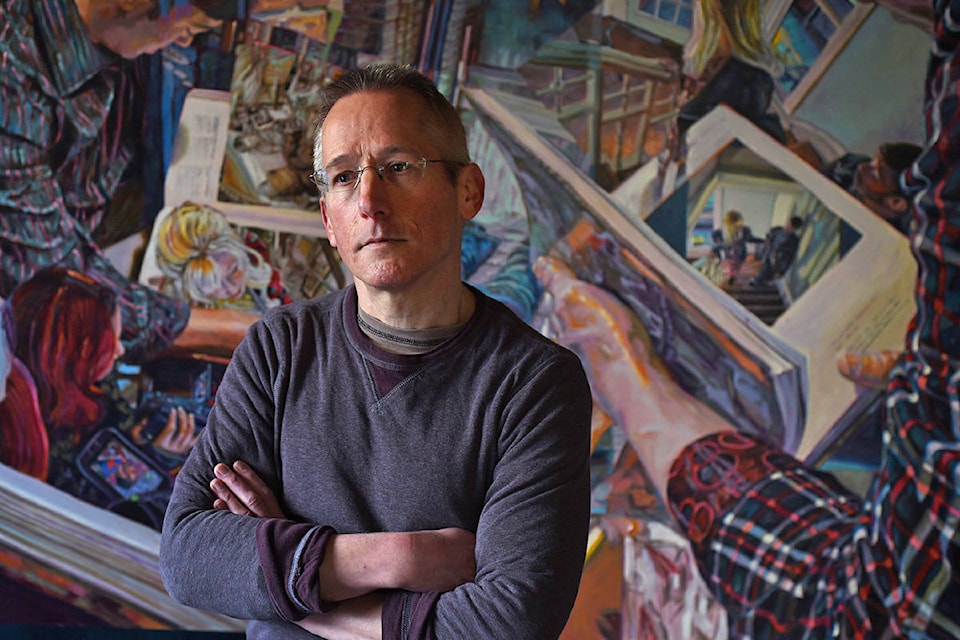-Story by Angela Cowan
Story courtesy of Boulevard Magazine, a Black Press Media publication
Like Boulevard Magazine on Facebook and follow them on Instagram
Behind creeping ivy and sprawling holly bushes, at the bottom of an octagonal tower in a house built well over a century ago, artist Brad Pasutti creates labyrinthine paintings that straddle the borders between dreams and reality.
Figures blend into unusual architecture or fade partly into translucence, while disembodied hands and limbs provoke that surreal sense of disjointedness often found in our subconscious minds.
The artist himself is soft-spoken and reserved as he moves through his home. Walls covered to the inch with pieces from local artists, shelves of figurines and models from classic works of art and his husband’s astonishing mermaid collection speak to the couple’s passion and dedication to the world of visual art.
He sets down a cup of tea and takes a chair in his studio next to a four-foot-tall painting, glancing at the piece.
“I hope to achieve some qualities of the dream,” says Pasutti of his work. “Dreams were very important to me. It’s so different than the waking world.”
In dreams, we jump from thought to thought, flitting between ideas that don’t always have a clear connection. Stare at one of Pasutti’s larger-than-life pieces in person and you’ll find your eye roaming from detail to detail, unable to focus on any one thing for long. It’s a reflection of the chaotic state of our slumbering minds, but also the wandering nature of daydreaming.
It’s what Pasutti calls the “polyphony of being” and relates to how people can be out in the world doing ordinary things, but our minds are constantly moving from one thought to the next, propelled by memories, the things we see, conversations we have, even music we hear.
“I want my paintings to be about what’s going on in people’s minds,” he says. “Very few people are just in the moment.”
Pasutti’s formal training started with a three-year honours diploma in sculpture from the Kootenay School of Art, completed in 1979, after which he achieved a Bachelor of Fine Arts from the University of Victoria in 1983. He was greatly inspired by Hieronymus Bosch, as well as Escher, Picasso and others. His original goals included researching conservation of artwork, but the intricacies of the science took him too far from the art itself.
“I realized I wasn’t into the sciences,” he says. Though fascinated by lay science, the details of conservation “seemed too removed from the actual process of doing art.”
The “geeky” side of painting continued to appeal, however, and the actual construction of the pigments attracted his interest. With his newest series, Pasutti has been experimenting with different mediums to mix with the oils to “see how they behave.”
Linseed oil, a common base in oil paints, can be “light and flowing or heavy and viscous,” he says, “and that has a huge influence on how you’re working.”
“The technological or geeky part is a whole different part,” he says, becoming animated as he talks about the ingredients used: casein, egg, plant derivatives. “The actual handling of paint, I want to explore that too. They don’t teach you that in school.”
But before he even begins work with his hand-ground colours, he starts his process by taking hundreds (if not thousands) of photos and then cutting and arranging them digitally to form a draft image he’ll work from.
| Artist Brad Pasutti in his Victoria studio. Don Denton photography |
His newest works-in-progress explore youth and wonder.
“I saw a small bush hedge that had a little dip down into the grass,” he says of his inspiration. “Childhood sees those as magical spaces. I wanted to capture childhood.”
After enlisting the help of his great-nephew and niece as models, Pasutti is now in the digital draft stage, discovering the stories the images tell with each click of his mouse. Though, there’s no guarantee the final piece will look anything like the drafts, he says.
As often happens in creative pursuits, the project takes on its own personality and the images “kind of grow” as Pasutti begins to work with actual paints.
“Once I start painting, it becomes an object, and there’s a dialogue between the works,” he says. “I’ve had works where what I started with…almost none of that actually ends up on the painting.”
And unexpected figures sometimes creep in as well. In several of Pasutti’s works, familiar faces from one of the artist’s favourite pieces, Bosch’s The Garden of Earthly Delights, kept appearing as he worked, sometimes to his chagrin.
But “the painting has to go in its own direction, and sometimes it surprises you.”
Inspired by a family with great respect for the arts, Pasutti has been exploring different perspectives since childhood.
“My father was a poet and a writer,” he says. “He used to bring art books home all the time. And my uncle went to art school. He was like a big brother to me.”
They encouraged Pasutti to explore his natural inclinations to view the world on a slant, and helped sow the seeds for his work to come.
As a child, Pasutti would walk around his home with a mirror pointed at the ceiling, seeing how the world was turned upside down. And from early childhood he would often dream of being in the depths of a labyrinth, having found secret doors in his home, or hidden floors and spaces.
“I was always so happy,” he says. “I enjoy just wandering.”
These days, Pasutti lives every day in his art. Inspiration strikes while walking the dog, wandering library stacks, even working on his iPhone.
“I’m always working,” he says with a laugh. He still dreams occasionally of labyrinths and secret places — his love of a complicated unknown as strong as ever.
